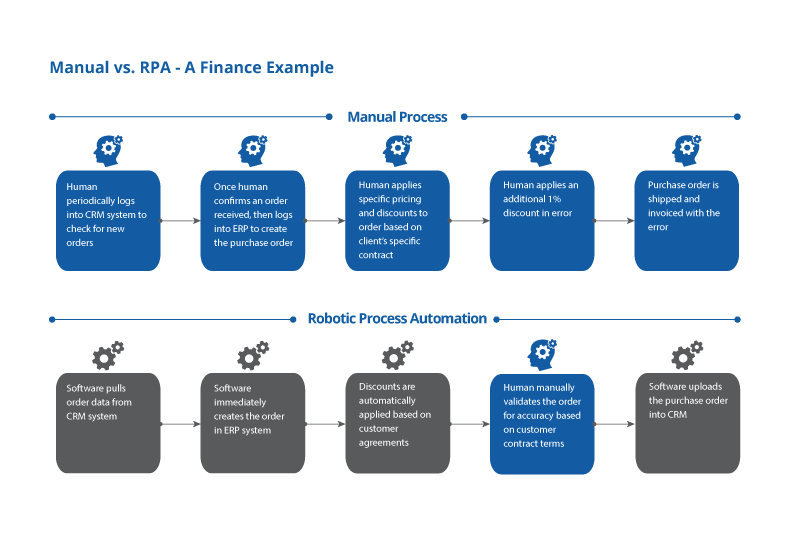What comes to mind when you hear the word “robot” and “robotic process automation”?
A clunky talking and walking contraption from a science fiction movie?
A specialized machine in an assembly line?
Technology that will take jobs away from working people?
Well, the robots we will describe to you are none of these things (and they definitely can’t walk, but they can learn to type!)
Every week, many of your valuable employees spend hours on repetitive and tedious tasks involving basic data entry, a series of mouse clicks or keyboard shortcuts, and file sharing and saving. This tedious but necessary work is the bane of your staff and typically generates the most errors, too. Wouldn’t it be great to free your employees for more high-value work and give them new skills?
Robotic Process Automation (RPA) has the power to make employees happier and bring new efficiencies and cost savings to your agency. But what exactly is it?
What is Robotic Process Automation?
RPA refers to software robots that observe how your employees interact with the graphical user interface (GUI) of different applications and learn how to complete specific tasks in the order they need to happen.
After training, a robot uses the same keystrokes and mouse clicks to perform the work in a virtual environment.

What Are Some RPA Use Cases?
The RPA creation process is wizard-driven and code-free, which empowers your employees to create multiple robots to handle repetitive tasks. RPA will be familiar to your IT staff because the steps in creating a robot are like the steps for developing software test automation, so you already have the expertise on board for a more sophisticated RPA.
Government agencies use RPA to automate both back-office and customer-facing functions. For example, financial transaction processing, transportation logistics, communications, and healthcare management are all areas where RPA can create significant cost savings and efficiencies.
Eliminating Corrections Process Bottlenecks in Collin County, TX
Collin County is part of the Dallas-Fort Worth-Arlington metro area and boasts a population of more than a million residents. In any area, large or small, crime and arrests are a fact, and the intake process is time-consuming. Collin County deputies spent 45 minutes entering personal information and charges into the onboard cruiser software for each detained individual. Then, detention officers needed 20 minutes at the jail to transfer the data into the booking system. With guidance from our experts, county staff created a digital worker that fetches the data from the cruiser software and transfers it automatically. And with over 10,000 arrests per year, Collin County has saved approximately 6,000 hours and $180K by implementing RPA.
Advantages of RPA
RPA Improves Efficiency
Robots execute basic copy-and-paste routines between applications 30%–50% faster than humans. Plus, they can work 24/7/365. No sick days or PTO!
RPA Integrates Disconnected IT Systems by Emulating Humans
Many agencies rely on specialized or even homegrown applications that are several years old and often disconnected from ERP or CRM systems. By mimicking the actions of a human who accesses several programs in multiple windows or screens, robots effectively integrate software applications without requiring your IT staff to write custom code or use APIs.
RPA Eliminates Errors
RPA works in a virtual environment and mimics when tasks have been completed perfectly, errors that come from number transpositions, double keystrokes, and other common data-entry mistakes are eliminated.
RPA Creates Happier and More Skilled Employees
With robots performing tedious and boring work, your employees gain time to focus on higher-value and more fulfilling work. And they get more done in less time. Plus, in the process of “teaching” their virtual workers how to perform various tasks, your staff can gain some basic technology skills and practice soft skills for things like email autoresponders and other constituent-facing messaging.
RPA Provides Insights Into Process Inefficiencies and Bottlenecks
The steps in creating RPA can provide “Aha!” moments that drive even greater efficiency and cost savings. As employees create RPA, they get the chance to analyze processes they do by memory, often from instructions passed down as tribal knowledge based on older versions of software. By examining how they work, employees often create more efficient ways of completing tasks, which RPA faithfully duplicates.
RPA Can Be the First Step in Deploying More Sophisticated Tools
RPA is low-cost and easy to implement because it does not require custom software code or APIs. Remember that a software robot works just like a human, only in a virtual environment.
By creating robots that perform multiple tasks and data exchanges between multiple systems, depending on certain conditions, your employees are creating Intelligent Automation (IA), Machine Learning (ML), and Artificial Intelligence (AI) are powerful tools trained to make decisions about outputs. Here, your CIO and IT staff team up with line-of-business leaders to create more sophisticated business logic to process business transactions and improve the customer experience.
RPA Is a Partnership, Not a Replacement
When you introduce your staff and organization to RPA, they must understand that software robots are allies, not competitors or replacements.






